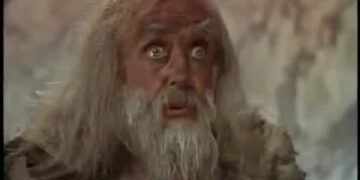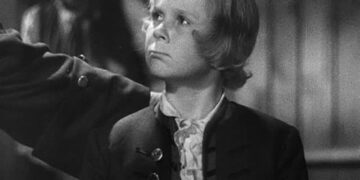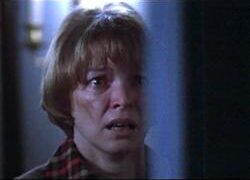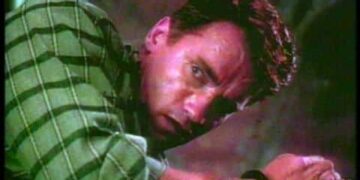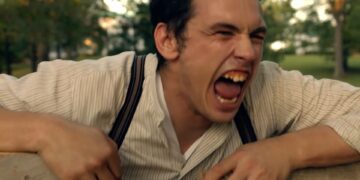“Filth” is a piece of literary brilliance by Irvine Welsh, an author known for his gritty and provocative style. It’s a book that takes readers on a dark journey into the life of a morally corrupt police officer, Bruce Robertson. The book delves into the themes of corruption, addiction, and mental health, providing a grim but compelling insight into the human condition.
The narrative of “Filth” is not for the faint-hearted. It is raw, intense, and often disturbing. Yet, it provides a deep exploration of the character that is both fascinating and thought-provoking. It’s a book that makes you question the lines between right and wrong, drawing you into its bleak and intricate world.
“Filth” was also adapted into an equally impactful movie by Jon S. Baird in 2013. The film brought the book’s grim narrative to life on the big screen, capturing the essence of Welsh’s writing in a visually stunning manner. Its realistic portrayal and compelling performances made it as memorable as the book, if not more.
Overview: Irvine Welsh – Biography and Works
Irvine Welsh, the author of “Filth,” is a Scottish novelist, playwright, and short story writer. He is popular for his distinctive writing style and unique narrative voice that often features Scottish dialects.
Welsh’s work is characterized by its raw, gritty realism, and exploration of darker themes such as addiction, poverty, and social decay.
Welsh’s most famous work is “Trainspotting,” a novel that provides a stark, realistic depiction of heroin addiction in Edinburgh. The book was later adapted into a critically acclaimed film directed by Danny Boyle. His other notable works include “The Acid House,” “Glue,” and “Crime.”
Throughout his career, Welsh has pushed boundaries and challenged norms, creating works that provoke thought and discussion. His work in “Filth” is no exception, as it delves into the moral corruption of a police officer, providing a grim but compelling narrative.
Comprehensive Book Summary of ‘Filth’
“Filth” is a book that centers around Bruce Robertson, a detective sergeant in the Edinburgh police force. The story delves into Bruce’s life, which is characterized by corruption, addiction, and mental health issues.
The book is narrated by Bruce himself, providing a first-person perspective of his life.
Throughout the narrative, Bruce engages in a series of morally questionable actions – from drug use and manipulation to sexual misconduct. As the story progresses, it becomes clear that Bruce is not just a morally corrupt officer, but also a deeply disturbed individual.
Despite his actions, Bruce is presented as a compelling character. His narrative voice is engaging, and his internal struggles provide a deep insight into his character. The book ends on a bleak note, with Bruce’s life spiraling out of control, reflecting the grim reality of his existence.
A Detailed Movie Summary of ‘Filth’
The film adaptation of “Filth,” directed by Jon S. Baird, remains faithful to the book’s narrative. It stars James McAvoy as Bruce Robertson, whose powerful performance brings the character to life on the big screen.
The film captures the essence of Welsh’s writing, presenting a visually stunning yet disturbing depiction of Bruce’s life.
It follows the same narrative as the book, delving into Bruce’s corruption, addiction, and mental health struggles. Despite its dark themes, the film also incorporates elements of dark humor, adding a unique twist to the story.
The film’s ending mirrors the book’s bleak conclusion, providing a powerful and impactful end to Bruce’s story. The performances, particularly McAvoy’s, combined with the film’s gritty realism, make it a must-watch for fans of Welsh’s work.
‘Filth’: The Parent Guide
“Filth,” both the book and the movie, delve into mature and complex themes that may not be suitable for younger audiences.
The narrative features explicit content, including drug use, sexual misconduct, and strong language. Therefore, parental guidance is advised for younger viewers and readers.
However, for older audiences, “Filth” can serve as a thought-provoking exploration of human nature and morality. It poses important questions about right and wrong and provides a stark depiction of the consequences of corruption and addiction.
Timeline: When ‘Filth’ Takes Place
“Filth” is set in the mid-1990s, a period characterized by significant social and cultural changes. The setting plays a crucial role in the narrative, reflecting the social decay and moral corruption that pervade Bruce’s life.
The mid-90s setting also adds an element of nostalgia to the story, capturing the zeitgeist of the era. The cultural references and social context provide a vivid backdrop for Bruce’s narrative, enhancing the overall impact of the story.
Exploring the Film Locations of ‘Filith’
The film adaptation of “Filth” was shot in various locations in Scotland, including Edinburgh and Glasgow. These locations play a significant role in the film, providing a visually stunning backdrop for the narrative.
Edinburgh, with its historic architecture and scenic landscapes, provides a stark contrast to the gritty realism of the story. Glasgow, on the other hand, with its urban landscapes and industrial scenes, adds to the bleak atmosphere of the film.
Understanding the Characters: ‘Who’s Who’ in ‘Filth’
“Filth” features a range of characters that contribute to the overall narrative. At the heart of the story is Bruce Robertson, the morally corrupt police officer whose life is marked by corruption and addiction.
Bruce is a complex character, whose internal struggles and moral dilemmas make him compelling, despite his actions.
Other notable characters include Ray Lennox, Bruce’s colleague who becomes a victim of his manipulation, and Clifford Blades, Bruce’s friend who also falls prey to his schemes. Each character in “Filth” plays a crucial role in the narrative, contributing to its overall impact.
Memorable Quotes from ‘Filth’
“Filth” is filled with memorable quotes that capture the essence of the narrative. Some of the most notable quotes include Bruce’s statement, “Same rules apply,” reflecting his belief that the same rules of corruption and immorality apply to everyone.
Another powerful quote is Bruce’s admission, “I used to be good at this job,” reflecting his recognition of his moral decay. These quotes, among others, provide a glimpse into Bruce’s mindset, adding depth to his character.
The Soundtrack by Clint Mansell: An Integral Part of ‘Filth’
The soundtrack of “Filth,” composed by Clint Mansell, is an integral part of the film. It sets the tone for the narrative, enhancing the overall atmosphere of the film. Mansell’s music captures the dark and gritty essence of the story, providing a fitting accompaniment to the visuals.
The soundtrack includes a mix of original scores and licensed tracks, reflecting the diverse range of emotions portrayed in the film. From the intense, dark tones of the original scores to the nostalgic tunes of the licensed tracks, the soundtrack adds a unique dimension to the film.
Curiosities and Trivia Related to ‘Filth’
“Filth” has its share of curiosities and trivia that add to its intrigue. For instance, the book features a tapeworm as a secondary narrator, a unique narrative device that adds a surreal touch to the story.
In the film, director Jon S. Baird makes a cameo appearance as a journalist. Additionally, the film’s lead, James McAvoy, reportedly put on weight and adopted a Scottish accent to portray Bruce Robertson convincingly.
These tidbits add an extra layer of interest to “Filth,” making it an even more fascinating piece of media.
Tips for ‘Filth’ Cosplay: How to Dress Like Characters
For fans looking to cosplay characters from “Filith,” the key is to capture the essence of the characters through their attire.
For Bruce, this would involve a classic police officer’s uniform, complete with a badge and handcuffs.
For other characters, such as Ray Lennox and Clifford Blades, the attire would reflect their respective roles in the story. Cosplaying “Filth” characters requires attention to detail and an understanding of the characters’ personalities, adding an extra layer of fun for fans.
‘Filth’ Ending Explained
The ending of “Filth,” both the book and the movie, is as bleak as the narrative itself. Bruce’s life spirals out of control, culminating in a tragic end that reflects the grim reality of his existence.
The ending is open to interpretation, allowing readers and viewers to draw their conclusions about Bruce’s fate. However, the overarching message is clear – the consequences of corruption and addiction can be devastating.
The Possibility of a Remake, Sequel, and Spin-off for ‘Filith’
Given the critical acclaim and popularity of “Filth,” there has been speculation about the possibility of a remake, sequel, or spin-off. However, as of now, there have been no official announcements.
A sequel or spin-off could explore the aftermath of Bruce’s story, delving into the lives of the other characters.
A remake, on the other hand, could provide a fresh take on the narrative. Regardless of the form it takes, any future adaptation of “Filth” would undoubtedly be eagerly anticipated by fans.
Other Media by Jon S. Baird
Jon S. Baird, the director of the “Filth” film adaptation, has several other notable works to his credit. His filmography includes “Cass,” a biographical crime drama, and “Stan & Ollie,” a biographical comedy-drama.
Baird is known for his distinctive filmmaking style, characterized by its gritty realism and compelling narratives. His work in “Filth” is a testament to his filmmaking prowess, capturing the essence of Welsh’s writing in a visually stunning manner.
Media Similar to ‘Filth’: Recommendations for Fans
For fans of “Filth,” there are several other books and films that offer similar themes and narratives.
These include “Trainspotting” by Irvine Welsh and its film adaptation, “A Clockwork Orange” by Anthony Burgess and its film adaptation, and “Fight Club” by Chuck Palahniuk and its film adaptation.
These works, like “Filth,” delve into dark themes and provide a stark depiction of human nature and morality. They offer a compelling exploration of the human condition, making them a must-read and watch for fans of “Filth.”
Other Works by Irvine Welsh
In addition to “Filth,” Irvine Welsh has several other notable works to his credit. These include “Trainspotting,” “The Acid House,” “Glue,” and “Crime.”
Each of these works reflects Welsh’s distinctive writing style and unique narrative voice. They delve into dark themes and provide a stark, realistic depiction of life, making them a must-read for fans of “Filth.”
Book Club Questions for ‘Filth’
“Filth” is a book that sparks discussion and debate, making it an interesting choice for book clubs.
Some questions that could be posed include: What does “Filth” say about human nature and morality? How does the book depict corruption and addiction? What does the ending signify? How does Bruce’s character evolve throughout the narrative?
These questions can foster engaging discussions, enhancing the book club experience.
‘Filth’ in the World of Video Games
While “Filth” has not been adapted into a video game, the narrative’s dark themes and complex character dynamics could lend themselves well to a video game format. A “Filth” video game could allow players to explore the gritty world of the narrative and engage with the characters in a more interactive manner.
A Travel Guide to Visit ‘Filth’ Locations
For fans looking to visit the locations featured in “Filth,” a trip to Scotland, particularly Edinburgh and Glasgow, would be in order. These cities offer a glimpse into the world of “Filth,” with their historic architecture and urban landscapes.
Visitors can explore the scenic landscapes of Edinburgh, the gritty urban scenes of Glasgow, and other locations featured in the film. This can provide a unique way for fans to engage with “Filth,” offering an immersive experience.
Conclusion
“Filth” is a compelling piece of literature and cinema that delves into dark themes and provides a stark depiction of human nature.
Whether you’re reading the book or watching the movie, “Filth” offers a thought-provoking exploration of corruption, addiction, and morality.
It’s a narrative that stays with you, making “Filth” a must-read and watch for fans of gritty realism and complex character dynamics.


